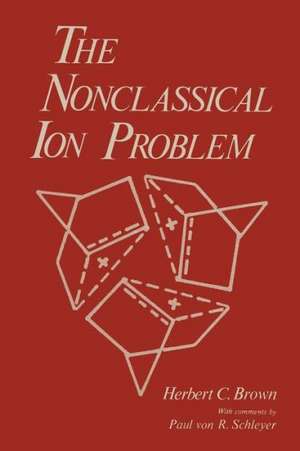The Nonclassical Ion Problem
Autor Herbert C. Brownen Limba Engleză Paperback – 12 oct 2011
Preț: 641.85 lei
Preț vechi: 755.13 lei
-15% Nou
Puncte Express: 963
Preț estimativ în valută:
122.82€ • 131.34$ • 102.40£
122.82€ • 131.34$ • 102.40£
Carte tipărită la comandă
Livrare economică 18 aprilie-02 mai
Preluare comenzi: 021 569.72.76
Specificații
ISBN-13: 9781461341208
ISBN-10: 1461341205
Pagini: 328
Ilustrații: 302 p. 5 illus.
Dimensiuni: 155 x 235 x 17 mm
Greutate: 0.46 kg
Ediția:1977
Editura: Springer Us
Colecția Springer
Locul publicării:New York, NY, United States
ISBN-10: 1461341205
Pagini: 328
Ilustrații: 302 p. 5 illus.
Dimensiuni: 155 x 235 x 17 mm
Greutate: 0.46 kg
Ediția:1977
Editura: Springer Us
Colecția Springer
Locul publicării:New York, NY, United States
Public țintă
ResearchCuprins
1. That Fascinating Nonclassical Ion Problem.- 1.1. Introduction.- 1.2. Origins.- 1.3. The Nonclassical Ion Era.- 1.4. Steric Assistance.- 1.5. An Alternative Interpretation.- 1.6. The Rococo Period of Carbonium Ion Structures.- 1.7. Difficulties in Challenging an Accepted Theory.- 1.8. Further Difficulties—A “Soft” Theory.- 1.9. Still Further Difficulties—Selective Reviews.- 1.10. Conclusion.- Comments.- 2. Steric Assistance in Solvolytic Processes.- 2.1. Introduction.- 2.2. Steric Assistance in the Solvolysis of Highly Branched Alkyl Derivatives.- 2.3. Steric Assistance in the Relative Effects of Methyl and tert-Butyl Groups.- 2.4. Steric Effects in Norbornyl Derivatives.- 2.5. Steric Effects in Ring Systems.- 2.6. Conclusion.- Comments.- 3. ?—Participation—A Factor in Fast Rates?.- 3.1. Introduction.- 3.2. n-, ?- and ?-Participation.- 3.3. ?-Participation and Fast Rates.- 3.4. ?-Participation vs. Steric Assistance.- 3.5. Steric Assistance—Not ?-Participation.- 3.6. The Fast Rates of Exo-Norbornyl and Cyclopropylcarbinyl.- Comments.- 4. Carbon-Bridged Cations.- 4.1. Introduction.- 4.2. What Is a Nonclassical Ion?.- 4.3. ?-Bridging vs. Hyperconjugation.- 4.4. Static Classical, Equilibrating Classical, or ?-Bridged Cations.- 4.5. Stereochemistry and ?-Bridged Cations.- 4.6. ?-and Aryl-Bridged Cations.- 4.7. Conclusion.- Comments.- 5. The Cyclopropylcarbinyl Cation.- 5.1. Introduction.- 5.2. Exceptionally Fast Rates of Solvolysis.- 5.3. Rearrangements in the Solvolysis of Cyclopropylcarbinyl Derivatives.- 5.4. ?-Bridged Structures for the Cation.- 5.5. Stereochemical Characteristics.- 5.5. Conclusion.- Comments.- 6.The 2-Norbornyl Cation.- 6.1. Introduction.- 6.2. Nonclassical “Structures” for the 2-Norbornyl Cation.- 6.3. Basic Facts.- 6.4.Transition State or Intermediate.- 6.5. Equilibrating Cations.- 6.6. Are Exo Rates Unusually Fast?.- 6.7. Do the High Exo:Endo Rate Ratios Require ?-Bridged Cations?.- 6.8. Do the High Exo:Endo Product Ratios Require ?-Bridged Cations?.- 6.9. Theoretical and Empirical Solutions.- 6.10. Conclusion.- Comments.- 7. Stabilized 2-Norbornyl Cations.- 7.1. Introduction.- 7.2. The Gassman-Fentiman Approach.- 7.3. Exo:Endo Rate Ratios in 2-p-Anisyl-2-norbornyl.- 7.4. Exo:Endo Rate Ratios in 2-p-Anisyl-2-camphenilyl.- 7.5. Exo:Endo Product Ratios.- 7.6. Goering-Schewene Diagrams.- 7.7. Other 2-p-Anisyl Systems.- 7.8. Other Stabilized Systems.- 7.9. The Selectivity Principle and the 2-Norbornyl Problem.- 7.10. Conclusion.- Comments.- 8. Exo:Endo Rate Ratios as a Steric Phenomenon.- 8.1. Introduction.- 8.2. Steric Characteristics of the Norbornyl System.- 8.3. Steric Characteristics of the 7,7-Dimethylnorbornyl System.- 8.4. Steric Hindrance to Ionization.- 8.5. Misconceptions.- 8.6. Steric Hindrance to Ionization and the Foote-Schleyer Correlation.- 8.7. Steric Effects in U-Shaped Systems.- 8.8. Exo:Endo Rate and Product Ratios as a Steric Phenomenon.- 8.9. Conclusion.- Comments.- 9. Equilibrating Tertiary 2-Norbornyl Cations.- 9.1. Introduction.- 9.2. Theoretical Considerations.- 9.3. The 1,2-Di-p-anisyl-2-norbornyl Cation.- 9.4. The 1,2-Diphenyl-2-norbornyl Cation.- 9.5. The 1,2-Dimethyl-2-norbornyl System.- 9.6. Conclusion.- Comments.- 10. Effect of Increasing Electron Demand.- 10.1. Introduction.- 10.2. Basic Considerations.- 10.3. Electron Demand in ?-Systems.- 10.4. Electron Demand in Cyclopropylcarbinyl Systems.- 10.5. Electron Demand in 2-Norbornyl Systems.- 10.6. Increasing Electron Demand in Secondary 2-Norbornyl.- 10.7. Extrapolation of Data from the Tertiary to theSecondary Systems.- 10.8. Conclusion.- Comments.- 11. Substituent and Structural Effects in 2-Norbornyl.- 11.1. Introduction.- 11.2. Secondary vs. Tertiary 2-Norbornyl Cations.- 11.3. Substituents as a Probe for Charge Delocalization.- 11.4. The Search for Charge Delocalization at C6.- 11.5. The Search for Charge Delocalization at C2.- 11.6. The Search for Charge Delocalization at C1.- 11.7. Deuterium as a Substituent.- 11.8. Deactivating Substituents.- 11.9. Structural Modifications.- 11.10. Conclusion.- Comments.- 12. Capture of Unsymmetrical 2-Norbornyl Cations.- 12.1. Introduction.- 12.2. Deamination of 2-Norbornylamine.- 12.3. Attempted Trapping of Unsymmetrical Cations in Solvolytic Processes.- 12.4. Capture of Unsymmetrical Cations in Solvolytic Processes.- 12.5. Additions to 2,3-Dideuterionorbornene.- 12.6. Addition of Deuterium Chloride to Norbornene.- 12.7. Addition of Deuteriotrifluoroacetic Acid to Norbornene.- 12.8. Addition of Perdeuterioacetic Acid to Norbornene.- 12.9. Resumé.- 12.10. Conclusions.- Comments.- 13. Equilibrating Cations under Stable Ion Conditions.- 13.1. Introduction.- 13.2. Equilibrating Cations.- 13.3. Applicability of Results to Solvolysis.- 13.4. 13C NMR Shifts as a Measure of Charge Delocalizations.- 13.5. Nonadditivity of 13C Shifts as a Basis for Nonclassical Structures.- 13.6. PMR Spectra.- 13.7. ESCA Spectra.- 13.8. Cation Stabilities.- 13.9. Conclusion.- Comments.- 14. New Concepts—New Systems.- 14.1. Introduction.- 14.2. The Hyperconjugative Model.- 14.3. The Exo-6-H Participation Model.- 14.4. The Search for a Stereoelectronic Contribution.- 14.5. New Proposed ?-Bridged Systems.- 14.6. Conclusion.- Comments.- 15. Final Comments.- 15.1. Introduction.- 15.2. The Search for ?-Participation and ?-Bridging.- 15.3. Does?-Delocalization Exist?.- 15.4. Are There ?-Bridged Cations?.- 15.5. Position on ?-Bridged Cations.- 15.6. Conclusion.- Comments.- Epilog.











